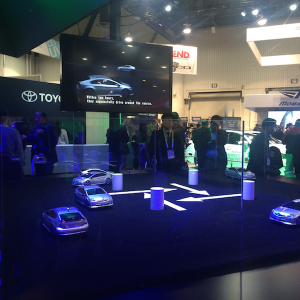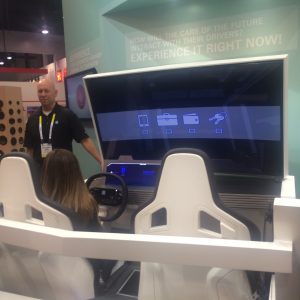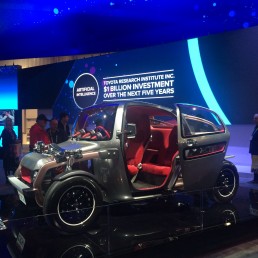Fast, secure data access is essential in the workings of every smart device and ecosystem. Even from behind the scenes it played a big role at this year’s CES. Data is at the center of almost every innovation – autonomous cars, camera drones and consumer IoT. At the same time it presents the biggest challenge of all. Huge amount of data is being continuously recorded to enable smart home and car. Recorded to a local storage it can lead to flash memory wear-out, file fragmentation and memory corruption that can cause frame drops. To be processed in a real time it needs to be recorded at a stable, high speed without any lag or slowdown.
Connected Car
 Connected car is a fast emerging consumer tech category. It was the star of CES, where almost every major car brand was showcasing latest automated features, which move far beyond adaptive cruise control or lane assist. In the advanced driver assistance and autonomous driving data is being recorded from multiple sensors and the cameras helping the car safely assess the situation on the road. Around the clock the system is bombarded with information from many different sources including traffic flow, vehicle maintenance and manufacturer updates. Facial monitoring, gestures and voice control are being developed to enable hands-off driving. However at this point most of the implemented technologies require driver’s hands on the steering wheel. Despite automotive players heavily investing in the new features, most probably we will not see a fully autonomous car until 2020.
Connected car is a fast emerging consumer tech category. It was the star of CES, where almost every major car brand was showcasing latest automated features, which move far beyond adaptive cruise control or lane assist. In the advanced driver assistance and autonomous driving data is being recorded from multiple sensors and the cameras helping the car safely assess the situation on the road. Around the clock the system is bombarded with information from many different sources including traffic flow, vehicle maintenance and manufacturer updates. Facial monitoring, gestures and voice control are being developed to enable hands-off driving. However at this point most of the implemented technologies require driver’s hands on the steering wheel. Despite automotive players heavily investing in the new features, most probably we will not see a fully autonomous car until 2020.
Internet of Things
 Cross-device connectivity is becoming reality with tighter smartphone integration and much improved link with the smart home. Advanced IoT systems allow to coordinate and access smart home devices from the outside and easy sync across multiple applications. Current main disruptors of the industry include: mobility, broadband and the cloud. Home automation itself is moving rapidly forward thanks to IoT consortiums such as AllSeen Alliance driving the ultimate device interoperability. CES saw an abundance of smart appliances outfitted with sensors including intelligent fridges and washers. Samsung went as far as offering a family hub that centers around the smart fridge. Every smart home system is now featuring camera monitoring that records events around the clock and sends alerts directly to your mobile phone. As the number of connected devices continues to grow, we need fast and robust home networks to sustain multiple applications running at the same time, heavy content transfers and high resolution video streaming.
Cross-device connectivity is becoming reality with tighter smartphone integration and much improved link with the smart home. Advanced IoT systems allow to coordinate and access smart home devices from the outside and easy sync across multiple applications. Current main disruptors of the industry include: mobility, broadband and the cloud. Home automation itself is moving rapidly forward thanks to IoT consortiums such as AllSeen Alliance driving the ultimate device interoperability. CES saw an abundance of smart appliances outfitted with sensors including intelligent fridges and washers. Samsung went as far as offering a family hub that centers around the smart fridge. Every smart home system is now featuring camera monitoring that records events around the clock and sends alerts directly to your mobile phone. As the number of connected devices continues to grow, we need fast and robust home networks to sustain multiple applications running at the same time, heavy content transfers and high resolution video streaming.


